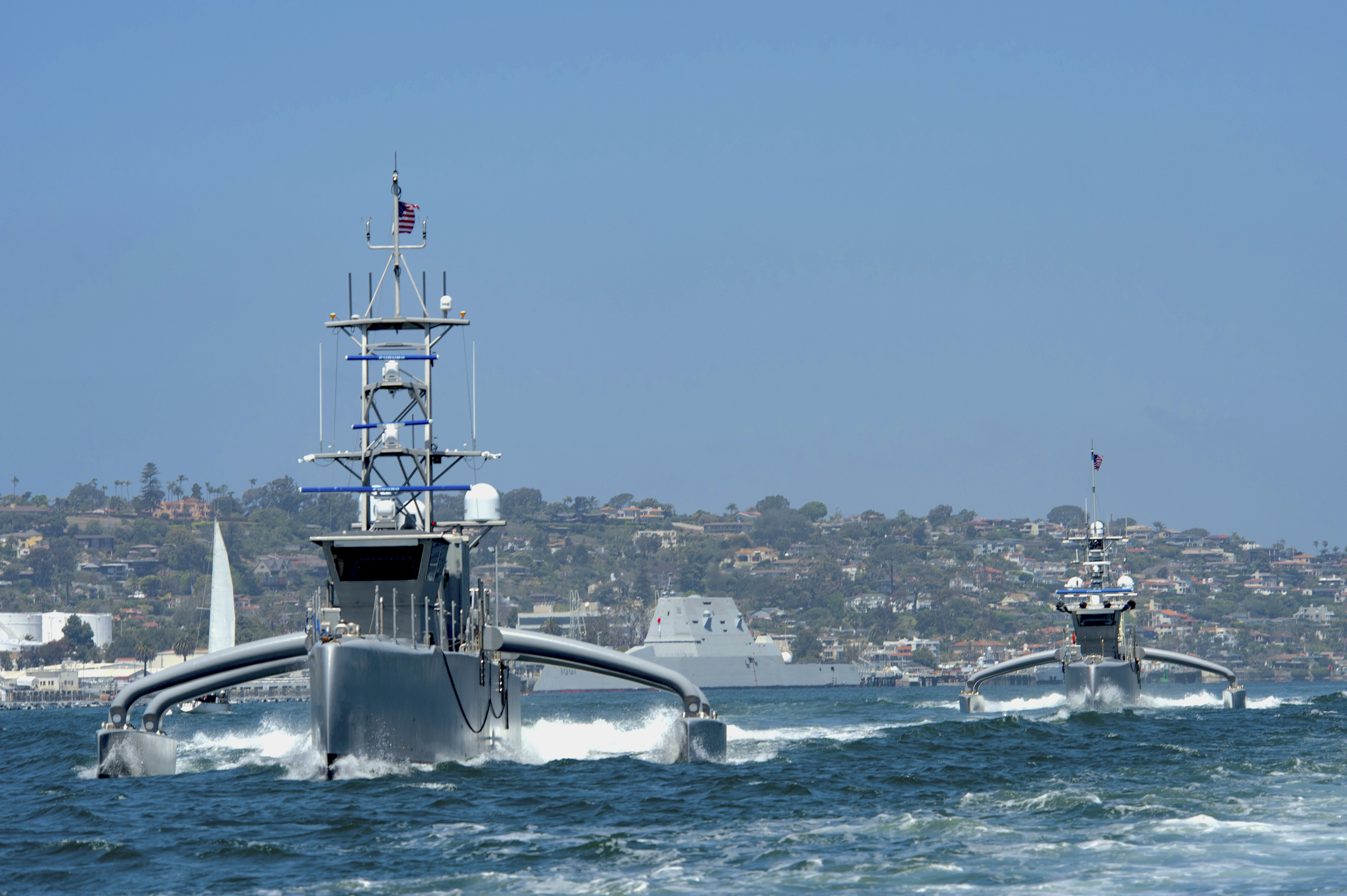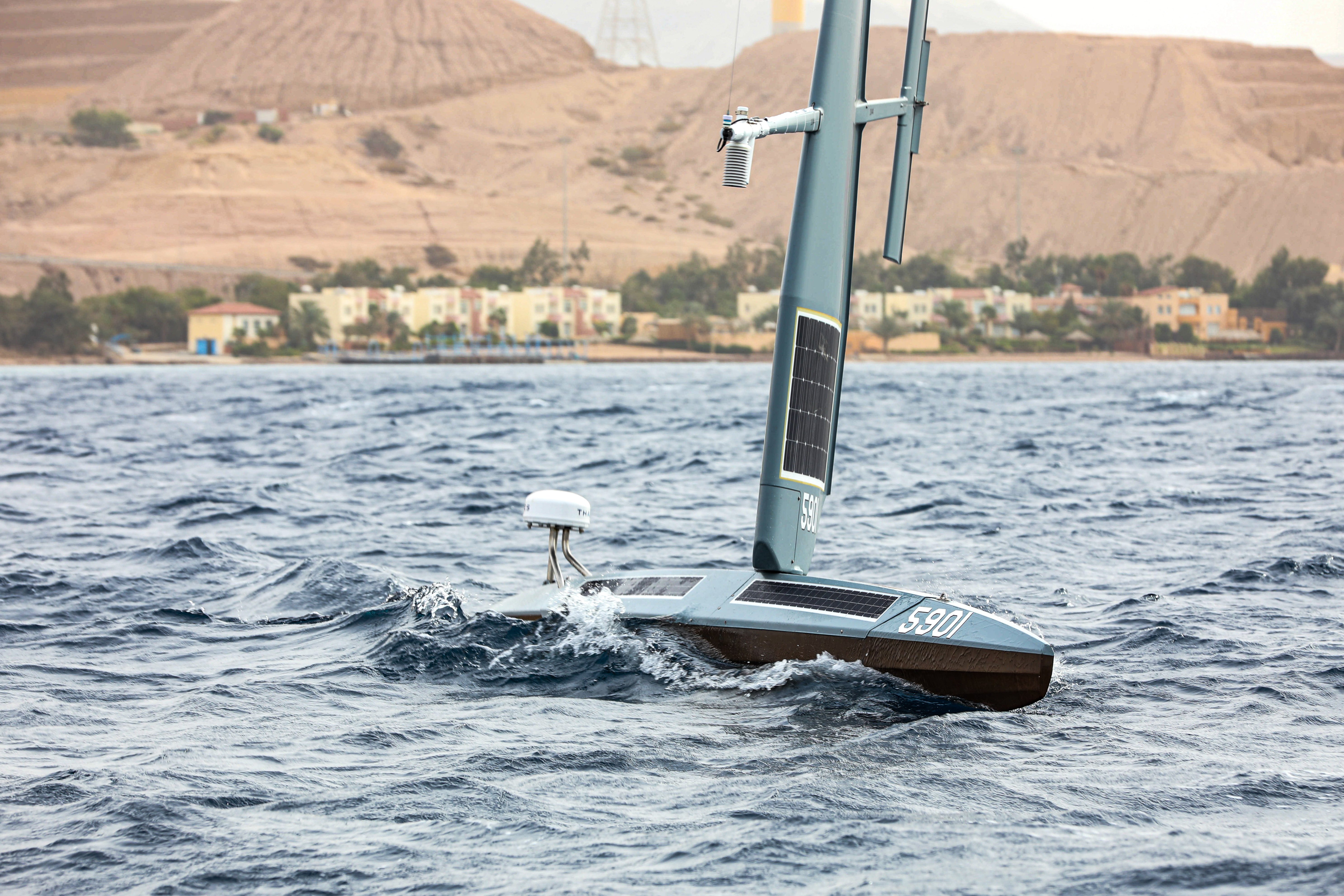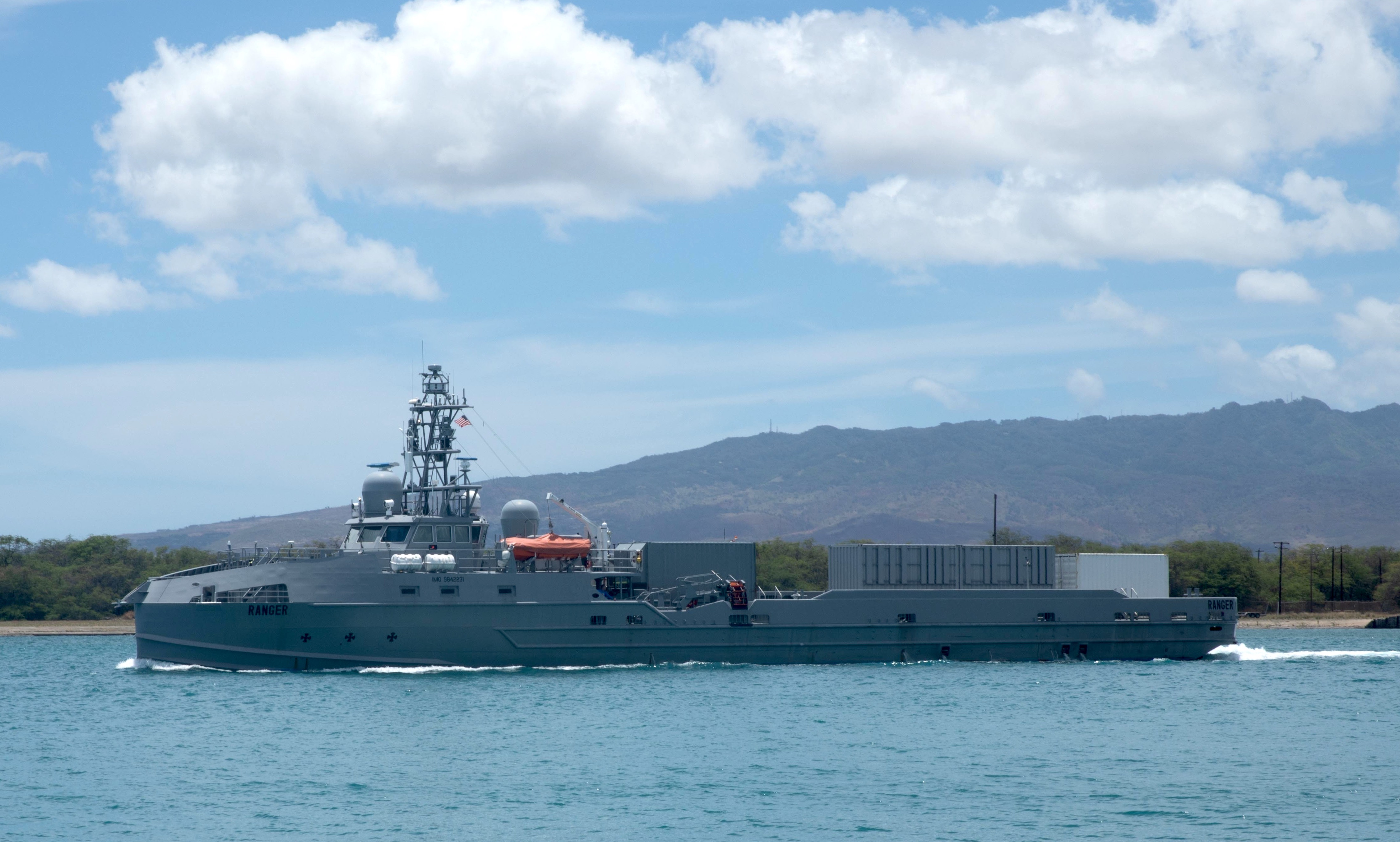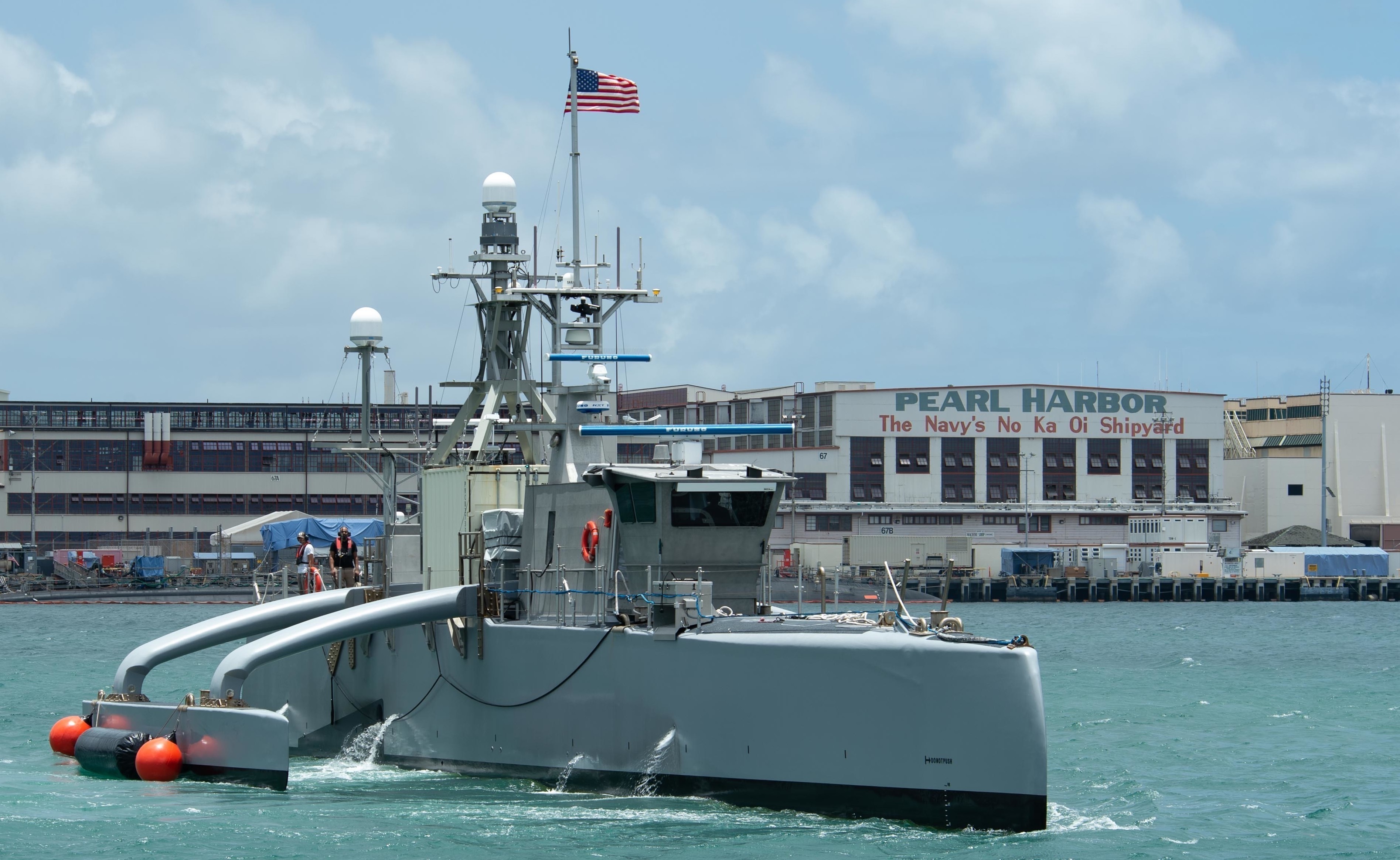
The manned-unmanned teaming experimentation currently underway at the biennial Rim of the Pacific 2022 exercise will help the Navy decide the future of the Medium Unmanned Surface Vehicle, a service official told reporters on Monday.
Speaking to reporters virtually, Rear Adm. Casey Moton, the program executive officer for unmanned and small combatants, noted that the Fiscal Year 2023 budget request did not include plans to buy more MUSV prototypes.
“Whether or not we will buy more MUSVs will be certainly informed by what we’re learning at RIMPAC. When we’ll decide that will be kind of when we’re ready to decide that. And I think even the CNO certainly has even commented on publicly about this discussion about what’s the best path in terms of MUSVs or smaller USVs, or those kinds of things, which I believe is a completely healthy conversation,” Moton said, referring to comments Chief of Naval Operations Adm. Mike Gilday made earlier this year.
While L3 Technologies is currently building a MUSV prototype, Gilday in April said the service is rethinking what it needs, including potentially the number of MUSVs, after seeing the experimentation U.S. 5th Fleet has been performing with smaller unmanned systems under the Combined Task Force 59 effort.
The Navy still plans to purchase the first Large Unmanned Surface Vehicle (LUSV) in FY 2025, Moton said on Monday.
“We are maturing all of the systems engineering pillars to get to the right level of technical maturity and we will achieve certification – which will include the senior technical authority – looking at that and our key technology areas: has the specific requirements for the land-based testing, for the machinery plant in particular, and other technical areas. So at its most fundamental level, the program office is using this as sort of a piece of its plan to get to those certification points and that transition to LUSV,” Moton said.
With four USV prototypes under the helm of the recently created Unmanned Surface Vessel Division One, the Navy is pairing the platforms with destroyers at RIMPAC to experiment with and better understand how the four USVs all work in conjunction with manned warships. The New USVDIV command will serve as the bridge between the program office and the fleet for that feedback, USNI News previously reported.
The USVs operating at RIMPAC include Ghost Fleet Overlord test ships Nomad and Ranger, which were originally developed by the Pentagon’s Strategic Capabilities Office. Sea Hunter, which was developed by the Defense Advanced Research Projects Agency, and its sister ship, Seahawk, are also taking part in the exercise. Sea Hunter and Seahawk are considered medium-sized USVs.
While it’s not the first time the Navy has paired the USVs with manned warships, it’s the first time all four USVs are participating in the same exercise, USNI News previously reported.

“It puts a different level of stress on it though because now I don’t just have one USV and a whole dedicated engineering staff just for that and fleet operators … But it puts a level of stress on not just the systems themselves, but the support behind it, right. So it’s not everyone’s focused on one thing. There’s four different things going on at the same time … and it’s a lot of the same people,” said Brian Fitzpatrick, the principal assistant program manager for USV’s at the Naval Sea Systems Command’s unmanned maritime systems program office, or PMS 406.
Moton described the RIMPAC testing as the “initial step in ramping up the scaling” of USV operations with the fleet.
The exercise paired a single USV with a single destroyer. Sea Hunter and Seahawk had crews embarked aboard their respective destroyers to operate the platforms from the ship, while Nomad and Ranger each had small crews aboard and were controlled from the operations center in San Diego. The plan is to keep scaling up as the Navy develops the concept of operations for the USVs.
“The CONOPS are not one USV with one surface combatant. It’s multiple USVs with a surface combatant,” Fitzpatrick said.
“That’s a scaling point that we didn’t do at RIMPAC. We had one USV assigned to one surface combatant. But those are steps. And then we’re going to continue to grow that and then continue to put in future exercises, we’ll have multiple USVs with one surface combatant, and then maybe multiple USVs tied with multiple surface combatants,” he continued. “So two and two or two and three. Those are things that were in the future CONOPs we’ve kind of identified we need to go do. So we’re going to go do those. But again, steps to scale to where we need to get to.”
During RIMPAC, the Navy had the chance to react in real-time to unplanned events, service officials said. At one point before a planned mission in the exercise, a destroyer had to drop out due to an issue officials declined to detail. That meant control of the USV had to switch to the shore-based unmanned operations center in San Diego, Calif.
Officials did not say which USV nor which destroyer experienced the change in plans, but said it provided the fleet with the chance to learn how to react to events it can’t control.
“The other thing that I suspect it probably did is it’s just one more thing to help build trust with the fleet. So if there’s an off nominal condition and we show the ability to take control, to move control off that vessel, to have the [unmanned operations center] perform its role, then that just gives the fleet more confidence in how the platform’s going to react, how the USVDIV is going to react. It will give more confidence, frankly probably up to the numbered fleet commander,” Moton said.
Fitzpatrick described the process of switching the controls to the shore-based UOC as “seamless.”
“That is really the longest part – it’s just the coordination and getting the people there. But again in an operational standpoint, using the Common Control System … it’s a few clicks on a screen,” he said.
“You have to relinquish control and then gather control over it.”

Capt. Scot Searles, the program manager for unmanned maritime systems, described the process as no different from when a manned ship starts reporting to another task group commander.
“It really is nothing more on the ship than making a report to say, ‘I’ve now left that commander and I’m now reporting to the new commander.’ But there’s a whole lot leading up to that … to make that sure everybody’s ready for that, so it’s the coordination piece of it that takes the longest,” Searles said. “But I think from our perspective what we learned is that’s a normal, expected off-nominal operation that all ships of the fleet are expected to be able to do seamlessly. And planned or unplanned, we were able to do it.”
The Navy did multiple planned transfers from a ship-based command of the USVs to a shore-based one, in addition to the one or two unplanned transfers, Searles said.
With four payloads at RIMPAC – including electronic warfare and anti-submarine warfare payloads – Fitzpatrick said feedback from the fleet has centered on getting more advanced and an increased quantity of payloads instead of whether the autonomy is working.
“That’s one of the biggest feedbacks we’re getting initially. They’re talking about payloads. They’re talking about capabilities,” he said. “They’re not worried that it’s going to go run into something.”
“They want to take Sea Hunter and an Overlord – which were developed under two different programs and have two different [communications] suites – and we’re working to bring them together. But they really want to do that. They want to say, ‘we want Sea Hunter and an Overlord with different payloads onboard, to be controlled from the same platform,” Fitzpatrick added.
The payloads have largely come from existing programs that the Office of Naval Research has altered so they could operate from an autonomous or unmanned platform.
“That’s the angle, right, is really trying to use existing technologies and make them work without people. And that’s the angle that allows us to rapidly get newer capabilities out there, to test them on all of the prototypes to inform the future requirements,” Fitzpatrick said.
Meanwhile, the Navy last week announced that its Unmanned Influence Sweep System, or UISS, reached initial operating capability, making it the first USV to hit that acquisition benchmark.

Moton noted that while the mission for UISS – which would pair with a Littoral Combat Ship or potentially other ships for the mine countermeasures mission – is different from that of the USVs the Navy is experimenting with at RIMPAC, it inches the Navy toward the future fleet of manned and unmanned platforms.
“Clearly it’s got a different mission, it’s under sort of local control of that asset that it’s operating from, whether that’s an LCS or a vessel of opportunity, or from the pier. It’s a different autonomy problem. It’s executing a mine warfare mission. It’s kind of going out and executing a traditional mine warfare sort of sweep of the area,” Moton said.
“It’s still the first time a fleet asset is going to be operating, is going to have to have trust in the autonomy, unmanned system trust in how it’s going to handle if there’s something that happens in the mission, whether it’s a mechanical thing or something else. So there are many reasons that it’s important in the broader push to hybrid man-unmanned,” he added.
After declaring IOC, the Navy will next head into the initial operational test and evaluation phase for the MCM mission package system once FY 2023 ends, according to Moton.
“Having [UISS] IOC – which means it’s through test, which means we have numbers fielded, which means we have trained crews, which mean we have logistics set up, all of which makes IOC so important – it’s just a huge milestone to get that done for our first surface MCM platform,” Moton said.





